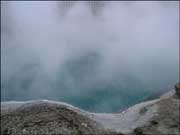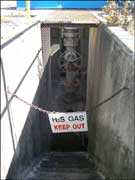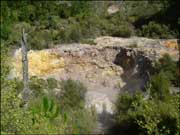5. The Dissolved Compounds
The
Wairakei Geothermal System contains large quantities of hot water and
steam. However this natural resource is unlike surface water or man made
steam because it contains a wide range of gases, salts and oxides, which
are dissolved into the water at high pressures and temperatures, deep
underground. These dissolved compounds provide both advantages and disadvantages
to power generation.
Advantages
- Concentrations of the dissolved salts allows the underground pressures and temperatures to be estimated. This allows what lies below to be predicted from the chemistry of surface springs
- The dissolved salts allow the easy passage of electric currents through the water. Therefore by measuring the flow of electricity through the ground it is possible to plot the extent of underground geothermal water. This technique has been widely used at Wairakei and across the whole Taupo Volcanic Zone. This means the boundary of a geothermal system is defined by a 'Resistivity Boundary' because the electrical resistance increases rapidly where the geothermal water runs out.
Disadvantages
Geothermal water is at such high temperatures and pressures
it is capable of causing severe scalds and burns from hot equipment.
The dissolved compounds in the water and steam can cause their own problems,
especially when they can no longer be dissolved as the temperature and
pressure drops.
For example
- Silica
Silica is the mineral SiO2 and is dissolved in hot deep thermal water. However at Wairakei it starts to deposit if the water temperature falls below 130°C. Controlling silica deposition enables more heat energy to be extracted from the water and is a major factor in determining the efficiency of power generation at Wairakei. - Hydrogen Sulfide gas
This lethal gas is colourless and at low concentrations smells like rotten eggs. However it quickly disables the sense of smell at high concentrations, making it dangerously odourless. Because it is denser than air it accumulates in depressions. - Carbon dioxide Gas
This is the most common dissolved gas in geothermal water and because it is also denser than air readily accumulates in depressions and enclosed spaces. It is colourless and odourless gas and is toxic in high concentrations. - Acid Sulfate lakes
These lakes form when Hydrogen sulfide escapes through the cap rock, then dissolves and oxidises in shallow groundwater to form Sulfuric acid. Acid sulfate lakes and pools may have a pH of 2 or less.
Effects on the Geothermal Field
Geothermal water and steam has been extracted for electricity generation since the mid 1950's and some effects are irreversible while extraction continues.
For example
- A drop in the level of hot water in the reservoir
- A drop in the pressure of the reservoir
- Subsidence of surrounding land
- Changes to local geysers, pools, mud pools and streams
- Changes in the ecology of the Waikato River between Huka Falls and Aratiatia Dam from discharges to the river
- Some minor warming of the Waikato River 1-3km downstream, but rarely beyond 25°C




